Dimmu Borgir
Melodic and sweeping black metal from the second wave that came to fill in the momentum needed as the old school of modern black metal musicians faded into incarceration or obscurity. Often silly but beautiful and resonant nonetheless, this band's only real work of value is "Stormblåst," since "For All Tid" is halfformed and "Enthrone Darkness Triumphant" is a ripoff of bands that were new when these musicians were born.
For All Tid
No Colours
|
1995
|
|
|
Production: This CD sounds as if it were mastered from tape or LP, as the sound is flat and abraded with too much guitar coming through as if projected into a room. Vocals are even background growling and drums and bass take their requisite parts with heavy diffusion like hearing battle through concrete.
Review: Melodramatic and overstyled Dimmu Borgir save their music through its essential rawness and punk heritage under the complexities of aesthetic. When the vocalist sings in a black metal style and does not try vocals he cannot accomplish his power is immense both rhythmically and tonally. Guitars are sawhorse consistency that breaks through simple tone patterns to provide a background ambience of fluid tone corridors for keyboards and vocals to traverse.
Tracklist:
1. Det nye riket
2. Under korpens vinger
3. Over bleknede blåner til dommedag
4. Stien
5. Glittertind
6. Fr all tid
7. Hunnerkongens sorgsvarte ferd over steppene
8. Raabjørn speiler draugheims skodde
9. Den gjemte sannhets herskar
Length: 43:19
|
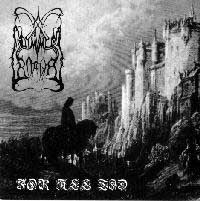
Copyright © 1995 No Colours
|
Built into this fusion is one of the oldest collaborations in rock music, between folk singsong and rhythmic speed in the style of amplified music from the industrial centers of humanity. The expressive rhythms are the interaction between strumming and the snare/bass heartbeat that blasts along behind the music's tonal avalanche. Vocals stagger the overall speed by holding rhythm or rejecting it, goading the surge or carefully denying it.
The positive side to the heavily emotional and over-expressed style of neo-opera that Dimmu Borgir offer is a compositional variation and thematic tension to each song, but the downside is that some of the judgement used to apply this principle results in staggeringly obvious musical exaggerations that will annoy the contemplative listener. The concept behind its power is the concept of atmosphere, whereby it launches into strobing riffs and alternating drumbeats very slowly while building mood with vocals and guitar melodies.
The result is a varied and increasing intensity, although one that maintains what power it has through absence of tension rather than conventionally articulated musical affinities. The execution of the parts, while strong, has to counterbalance overall compsition. If you can stand random chanted, or (poorly) clean sung vocals, often layered on melodramatic keyboards and swarmy rock-derivate riffing, and don't mind the overuse of sweeping keyboards, this can bring some positive vibe to your consciousness.
But far too often the effect is redundant, which is in the individual instantiations annoying but in the context of the song usually just areas greyed into into devastated, indistinguishable monotony. For this epic style I commend this band as innovators where they could find space, but not groundbreakers who invent territory from the ashes of uncomprehended others.
|
Stormblåst
Cacophonous
|
1996
|
|
|
Production: Clear and bold with outrageously textual tone on the instruments diminished behind perhaps too much polish, a mix that leaves keyboards high and back-of-room over everything else but preserves all instruments clearly.
Review: Swooning beautiful melodies and dark passages of dissonant but electric sweet attraction within the song propel this music, its dissidence drawn from the school of fantasy and the mystical, who illustrate a vast potential to drown out the tedious mediocrity of the world. Dimmu Borgir make flowing and sweeping melodic black metal with small parts of melodies held together in the encompassing mood of the aesthetic, its catchy, goofy and sometimes heavily kitsched but consistently attractive melodic mainlines.
In this style the percussion patterns remain consistent for each segment of the song, allowing the stringed instruments to define the shifting elements of the overall rhythmic signatures, covered by keyboards adding counterpoint melodic patterns or integrating into the dominant tendency another layer of aesthetic. Each instrument can define its own leads when necessary or add complexity behind segmented complexity.
Drums provide an example of complexity integrated under very simple external structure; like most atmospheric or ambient metal bands they bash along a dominant rhythm with subpatterns providing internal tension and balance to the overarching tendency. This deconstruction allows the anarchistic distribution of the concept of the song into finely differentiated pieces which evolve a mood from shaping to conclusion with shadows contrasting ideals.
As the beats hold themselves apart, the melodies pour through in the stream of subrhythm specified by the strumming hands of the guitarists. Over this flows the tonal abundance of the keyboard, holding the textural voice of the guitar at opposition, all synchronized to the alternating pulse of drums and directionally defined by the sharper, more chaotic percussive aspects of individual phrases of drum track.
Tracklist:
1. Alt Lys Er Svunnet Hen
2. Broderskapets Ring
3. Når Sjelen Hentes Til Helvete
4. Sorgens Kammer
5. Da Den Kristne Satte Livet Til
6. Stormblåst
7. Dødsferd
8. Antikrist
9. Vinder fra en Ensom Grav
10. Guds Fortapelse - Åpenbaring av Dommedag
Length: 49:42
|
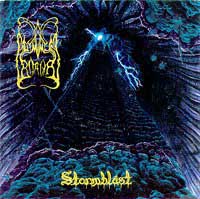
Copyright © 1996 Cacophonous
|
Careful use of snare (variations on technical death metal double-hit drumming, more on the off beats), highhat and cymbal microhit riffing, and tom enable the complexity beneath such simple rhymes of musical affinity to direct what is otherwise detached and repetitive patterns sometimes recognized as epic for their invokation of cultural resemblances (illustrated here by the bizarrely half-good half-awful classical-esque keyboard compositions and baroque music layered to introduce the final track).
Where this succeeds is its organic romanticism which can accept its frivolousness, laziness and cheesiness as part of an epic attempt to communicate another vision of world, like a layer of understanding beyond what mortal minds attempt to comprehend. The over-emotionalism can bug you out, but if you can train your brain to release itself to enjoy this music it is a distinctive take on ambient construction.
The tones used here are simple variations in relatively conventional styles, not needing more than very simple elements of similarity and dissonance to create the fractional patterns collaged to build linear songs.
Vocals help string it together, by either chanting thick darkly inflected voices to the leading rhythm of the song, or by adding another internal rhythm to the vector of each phrase in a black metal screech complacently socketed in echo effects. Texture of the vocals does not vary much at all, which is where a more serious (Burzum) vocalist would add another interpretation in small rhythms and timbre changes.
The keyboardist is out of control, with two or three major breaks or intros per half album, creating both beauty and streamlined functional objects in songs and predictable happy keyboard turd that periodically litters the first half of this thing. Mostly, however, the guitarists save it in time with slashing rainfall of guitars racing through the cataclysmic strife of indefinition. In this there is a profound abstract presence of nostalgia in this music: the perfectly formed, conventionally-coherent keyboards against the guitar, which is mostly rhythm and timbre with melody adding complexity.
The more concrete elements of these songs are some amazing rhythms and tangibly powerful guitar lines that, although simple, bring the metal into this music as fundamental logic. Overall structuring while simple and frequently repetitive, brings suprises in continuity and expectations, and the pattern-level structuring of this conception provides a simple lexicon of phrase attributes which are manipulated here for ambient effect, breaking the idea of the whole through each incarnation of the many subelements (in this case, the sample of time between beat(s)).
It would be foolish not to recognize the cheese factor here, however; this can be portrayed as sappy material without damaging its essential character, but even in the language of emotional retards these individuals have managed to express something vaguely sublime in their musical meanderings. I enjoy this release and recommend it with the filter attribute of overemotionalism.
|
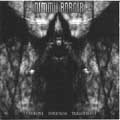
1. Mourning Palace
2. Spellbound (by the Devil)
3. In Death's Embrace
4. Relinquishment of Spirit and Flesh
5. The Night Masquerade
6. Tormentor of Christian Souls
7. Entrance
8. Master of Disharmony
9. Prudence's Fall
10. Succubus in Rapture
11. Raabjørn Speiler Draugheimens Skodde
Length: 56:43
|
Enthrone Darkness Triumphant (Nuclear Blast 1997)
Veering away from the neoclassical orchestration that made Stormblåst brilliant, Dimmu Borgir instead fill a pop album with heavy metal riffs and bouncy melodies trailing happily irrelevant keyboards and black metal trappings behind. There is no sense of theme, only of rock-based song form, and all previous passion has been directed into raw speed thrills and pointless pseudo-blasphemy. With most other albums in metal being better than this one, it is impossible to imagine buying it.
|
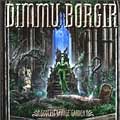
1. Moonchild Domain
2. Hunnerkongen
3. Chaos without Prophecy
4. Raabjørn Speiler Draugheimens Skodde
5. Metal Heart
6. Stormblåst (live)
7. Master of Disharmony (live)
8. In Death's Embrace (live)
Length: 41:16
|
Godless Savage Garden (Nuclear Blast 1998)
On this EP of mostly rehashed material Dimmu Borgir merge raw versions of their older music with stripped down takes from their newer style, coming up with a handy method of ripping off black metal in sound without discovering any of the musicality it once had. Although all of us "true" underground heads are in theory going to rush out and buy the "raw" Dimmu Borgir, there is nothing contributed over their first two albums and no new innovation to correct their last disaster.
|
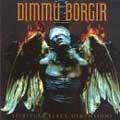
1. Reptile
2. Behind The Curtains Of Night - Phantasmagoria
3. Dreamside Dominions
4. United In Unhallowed Grace
5. The Promised Future Aeons
6. The Blazing Monoliths Of Defiance
7. The Insight And The Catharsis
8. Grotesquery Conceiled (Within Measureless Magic)
9. Arcane Lifeforce Mysteria
Length: 49:17
|
Spiritual Black Dimensions (Nuclear Blast 1999)
Everything that made later Emperor terrible and allowed Cradle of Filth to rise above worthier bands is here in this album, a rock-n-roll tour of symphonic black metal as crafted in either 1) wandering phrases that touch dissonance but spend time in consonant, pentatonic variations or 2) sudden blasting power chord riffs of meaningless, random intervals. Like other postmodern blackmetallers Satyricon, this band seem to believe that making music without sense from a collage of the past is innovation and are willing to take you along for the ride if you let them.
|
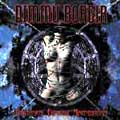
1. Intro
2. Blessing Upon The Throne Of Tyranny
3. Indoctrination
4. Sympozium
5. The Maelstrom Mephisto
6. Hybrid Stigmata - The Apostasy
7. Puritania
8. Perfection Or Vanity
9. Kings Of Carnival Creation
10. Absolute Sole Right
11. Architecture Of A Genocidal Nature
12. Burn In Hell
Length: 63:04
|
Puritanical Euphoric Misanthropia (Nuclear Blast 2001)
The cheesewagon returns with this pointless detour into black metal appearance with the heart of Christian radio in making sappy, overindulgent, rehashed randomness within a rock format to convince suburban "normals" that they, too, can get into black metal. Sure there are changes in style, but for the most part, these are surface only and obscure the fact that nothing has changed throughout the Dimmu Borgir albums after Stormblåst - when mediocre artists are out of new ideas, they head for the cheese factory and ripoff their influences. This album is a great example of what not to do unless you care about nothing but money, in which case, future Marilyn Mansons of the world, feast!
|
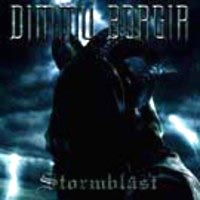
Tracklist
1. Alt lys er svunnet hen
2. Broderskapets ring
3. Nar sjelen hentes til helvete
4. Sorgens kammer - del II
5. Da den kristne satte livet til
6. Stormblåst
7. Dodsferd
8. Antikrist
9. Vinder fra en ensam grav
10. Guds forstapelse - Åpenbaring av dommedag
11. Avmaktslave
Length: 51:21
|
Stormblast 2005 (Nuclear Blast, 2005)
The updated interpretation of the only really quality work from Dimmu Borgir, "Stormblast," removes apparently plagiarized keyboard tracks inserted by former keysman Stian Arstad and updates the sound of this classic work to match the now-trademark Dimmu Borgir hybrid of Cradle of Filth dramatics and underground metal sensibilities. While the instrumentalism is better and the beauty of these original songs shines through, the narrow filter through which the band have forced interpretation of these songs detracts from much of their beauty. The highly-touted drumming of Hellhammer, for example, is phoned in; any of a hundred thousand drummers could have done this quasi-Bard Faust interpretation that is invariant as if done in a weekend. Dynamics are squelched and the interplay of keyboards and guitars sloughed off; the result is that like a hardcore band, everything must be forced through the single instrument while drums keep time and vocals comment, which depletes the ambition of this album as well as its inherent aesthetic beauty. Not surprisingly, almost every song sounds like it was faded early, being incomplete because it lacks so many original elements. Undoubtedly, this will sell well, but then again, that has never necessarily been an indication of quality.
|
BLACK | DEATH | HEAVY | SPEED | THRASH | GRINDCORE
Copyright © 1988-2004 the Dark Legions Archive
|






